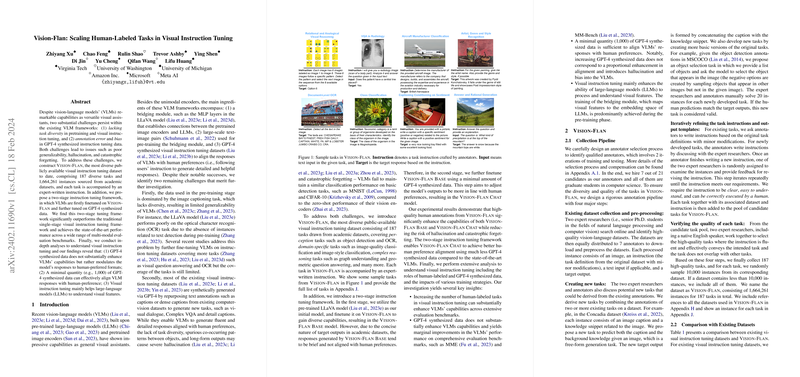Vision-Flan: Advancements in Visual Instruction Tuning through Human-Labeled Datasets
Introduction to VISION-FLAN
Recent advancements in vision-LLMs (VLMs) have demonstrated impressive capabilities, acting as potent visual assistants for a myriad of tasks. Yet, these systems have historically grappled with two main challenges: the first being a scarcity of task diversity in their pretraining and instruction tuning phases, and the second concerning the prevalence of annotation errors and biases in datasets synthesized by models like GPT-4. Addressing these, the paper introduces VISION-FLAN, a novel dataset that emerges as the most diverse publicly available visual instruction tuning dataset to date. Encompassing 187 tasks and over 1.6 million instances sourced from a wide array of academic datasets, and supplemented by expert-written instructions, VISION-FLAN marks a significant stride toward enriching the training landscape of VLMs.
Two-Stage Instruction Tuning Framework
In an innovative approach to instruction tuning, VISION-FLAN employs a two-stage framework. Initially, VLMs undergo fine-tuning on the VISION-FLAN dataset to acquire a broad spectrum of capabilities. This phase yields the VISION-FLAN BASE model. Recognizing the concise nature of academic dataset outputs and their misalignment with user preferences, a subsequent fine-tuning phase on a minimal set of GPT-4 synthesized data is conducted. This sequential method addresses the challenges of generalizability, hallucination, and catastrophic forgetting, presenting a refined model—VISION-FLAN CHAT—that aligns closely with human preferences while necessitating considerably less GPT-4 synthesized data.
Empirical Findings and Analysis
The extensive experimental evaluation demonstrates that models fine-tuned on the VISION-FLAN dataset exhibit superior performance across various multimodal evaluation benchmarks. The incorporation of a rich array of human-labeled tasks substantially boosts the models' capabilities. Intriguingly, the research reveals that while GPT-4 synthesized datasets do not significantly enhance VLMs' capabilities, they play a crucial role in modulating model responses to align with format and style preferences favored by humans. Furthermore, the investigation sheds light on the predominant role of visual instruction tuning in enhancing large-LLMs' comprehension of visual features, a critical undertaking facilitated largely during the pretraining phase.
Theoretical and Practical Implications
This research holds both theoretical significance in understanding visual instruction tuning's impact on LLMs and practical implications for developing more capable and human-aligned VLMs. The introduction of the VISION-FLAN dataset, coupled with the novel two-stage fine-tuning framework, provides a fertile ground for future inquiries into fine-tuning techniques and the development of generalized models that excel in a broader range of tasks. It positions visual instruction tuning as a critical pivot for advancing the integration of visual understanding within LLMs, promising enhancements in the utility and applicability of VLMs in real-world scenarios.
Future Directions
The establishment of VISION-FLAN as a diverse visual instruction tuning resource opens avenues for exploring multifaceted instruction tuning strategies, extending beyond the visual domain to incorporate multi-modal and multi-lingual contexts. Future research could delve into refining the synthesis of visual instruction tuning datasets, leveraging advancements in generative models to produce highly diverse, realistic, and human-aligned datasets. As VLMs continue to evolve, the exploration of scalable, efficient fine-tuning mechanisms remains paramount, promising to unveil models with unprecedented versatility and robustness across a spectrum of tasks and domains.
